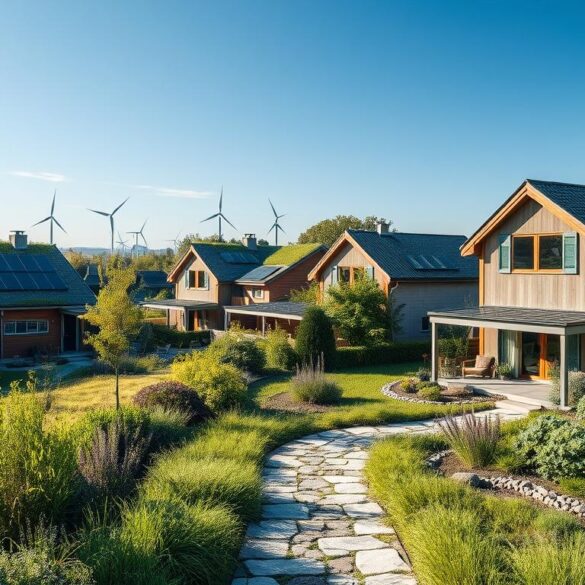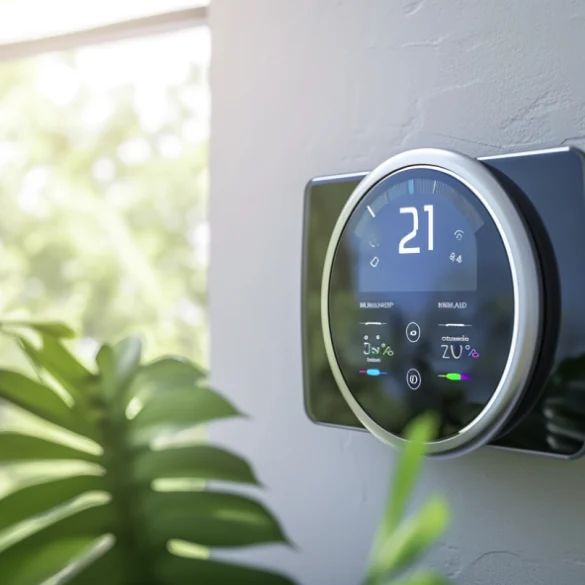Transforming a traditional office into a green, sustainable workspace is an essential step for businesses to contribute to environmental conservation. By embracing sustainable practices, you can create a work environment that prioritizes eco-consciousness and supports a healthier planet.
In this comprehensive guide, we will explore various strategies to achieve a green home office. From harnessing natural light and using energy-efficient appliances to implementing sustainable commercial printing solutions and choosing green office supplies, we will provide you with practical tips to create an environmentally friendly and energy-efficient workspace.
By adopting these sustainable office practices, you can not only reduce your carbon footprint but also promote a more productive and healthier work environment for yourself and your employees.
Key Takeaways for Green Home Office
- Create a sustainable work environment by implementing green office practices
- Maximize natural light to reduce energy consumption and improve well-being
- Use energy-efficient appliances and embrace sustainable printing solutions
- Choose eco-friendly office supplies and practice the three R’s: reduce, reuse, recycle
- Promote green commuting options and incorporate indoor greenery for a healthier workspace

Harnessing Natural Light for a Green Home Office
Utilizing natural light in your home office can have numerous benefits, both for the environment and your well-being. By harnessing natural light, you can reduce your reliance on artificial lighting and create a sustainable and eco-friendly workspace.
Incorporating strategies that maximize sunlight penetration, such as installing skylights, large windows, and light shelves, can significantly enhance the amount of natural light in your office. This not only saves energy but also has a positive impact on your mood, productivity, and overall health.
The health benefits of natural light are well-documented. Exposure to natural light can help regulate your sleep-wake cycle, improve vitamin D levels, and reduce the risk of certain health conditions. Additionally, natural light can minimize eye strain, headaches, and fatigue, allowing you to work comfortably and efficiently.
When designing your home office, consider sustainable office lighting options that make the most of natural light. Opt for energy-saving light bulbs, such as LED or CFL bulbs, which consume less energy and have a longer lifespan. This not only reduces your carbon footprint but also saves you money on energy bills in the long run.
So, open up those curtains, position your desk near a window, and let natural light illuminate your workspace. Embrace the beauty of natural light while creating an eco-friendly and health-conscious office environment.
Green Home Office.
- Maximize sunlight penetration by incorporating skylights, large windows, and light shelves.
- Utilizing natural light improves mood, reduces eye strain, and enhances productivity.
- Exposure to natural light provides various health benefits, such as regulating sleep patterns and improving vitamin D levels.
- Choose energy-saving light bulbs, such as LED or CFL bulbs, to further reduce energy consumption.

Using Energy-Efficient Appliances for a Sustainable Workspace
Creating a sustainable office environment involves making conscious choices to reduce energy consumption and minimize the carbon footprint of your workspace. One effective strategy is to switch to energy-efficient appliances that prioritize energy-saving practices. Energy Star-rated appliances in particular are designed to consume less power while maintaining optimal functionality. By incorporating these energy-saving appliances into your office setup, you can contribute to a greener, eco-friendly office while enjoying long-term cost savings.
Energy Star is a widely recognized certification program that identifies appliances and equipment that meet strict energy efficiency standards. When you choose Energy Star-rated computers, printers, coffee makers, and HVAC systems, you are not only reducing your carbon emissions but also benefiting from lower energy bills and increased durability. These appliances are designed to operate efficiently, ensuring minimal energy waste and maximum performance.
By investing in energy-efficient appliances for your workspace, you are taking a significant step toward reducing your carbon footprint. Operating energy-efficient devices can lead to substantial energy savings, which directly contributes to a more sustainable environment. Additionally, incorporating eco-friendly office equipment aligns with your commitment to reducing resource consumption and promoting a greener business model.
The Benefits of Energy-Efficient Appliances for a Green Home Office
Using energy-efficient appliances offers numerous benefits that extend beyond environmental considerations:
- Reduced energy consumption: Energy-efficient appliances consume less power, resulting in lower energy bills and long-term cost savings.
- Lower carbon emissions: By reducing energy consumption, these appliances contribute to the overall effort of combating climate change by minimizing carbon emissions.
- Enhanced performance and durability: Energy-efficient appliances are designed to operate optimally while consuming less energy. They often have longer lifespans and require less maintenance, resulting in greater reliability and overall cost-efficiency.
- Improved indoor air quality: Some energy-efficient appliances, such as HVAC systems, are equipped with advanced filtration technology that helps maintain cleaner and healthier indoor air quality for a more productive and comfortable workspace.
To help you visualize the positive impact of energy-efficient appliances, here is a table showcasing the potential energy savings and reductions in carbon emissions resulting from the use of these appliances in a typical office:
| Appliance | Annual Energy Savings (kWh) | Annual Cost Savings ($) | Annual CO2 Reduction (lbs) |
|---|---|---|---|
| Energy Star-rated computer | 150 | 15 | 195 |
| Energy Star-rated printer | 100 | 10 | 130 |
| Energy Star-rated coffee maker | 50 | 5 | 65 |
| Energy Star-rated HVAC system | 500 | 50 | 650 |
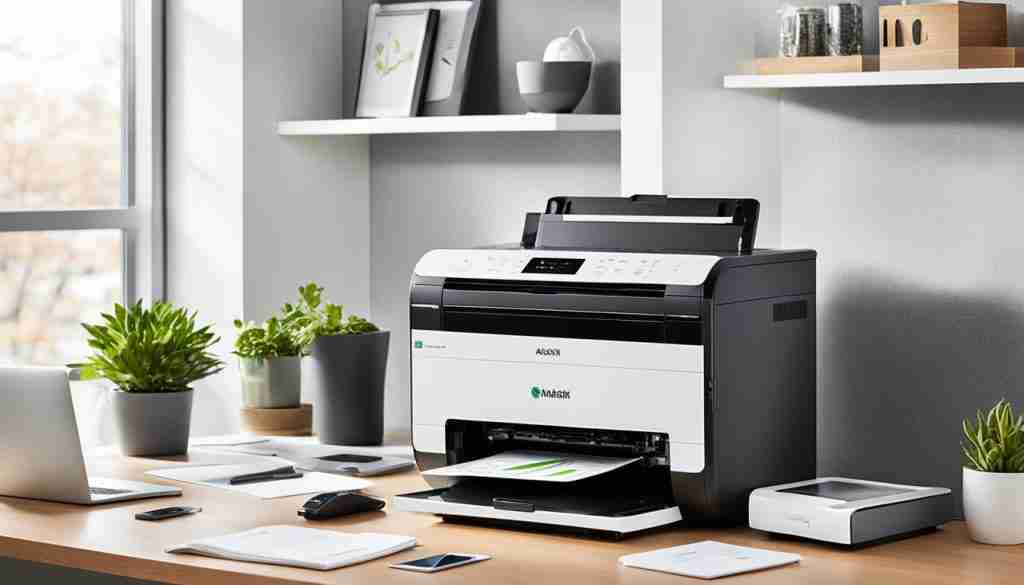
These figures are approximate and serve as a general representation of the potential savings that can be achieved through the use of energy-efficient appliances. Actual results may vary depending on specific circumstances and usage patterns.
By embracing energy-saving practices and utilizing energy-efficient appliances in your office, you are actively contributing to a more sustainable workspace. The reduced energy consumption and carbon emissions not only benefit the environment but also create a positive image for your business as it aligns with eco-friendly practices and reduces its overall impact on the planet.
Implementing Sustainable Commercial Printing Solutions
In today’s digital era, printing is still an essential aspect of many businesses. However, traditional printing practices can have a significant environmental impact. To create a more sustainable office, it is crucial to implement sustainable commercial printing solutions. By adopting eco-friendly strategies, you can reduce your carbon footprint and contribute to a greener future.
Using Energy-Efficient Printers
One way to make your printing practices more sustainable is by using energy-efficient printers. Look for printers with an Energy Star rating, which indicates that they meet strict energy efficiency guidelines set by the Environmental Protection Agency. These printers are designed to consume less power, resulting in reduced energy consumption and lower greenhouse gas emissions.
Choosing Recycled Paper for Your Green Home Office
Another important consideration is the type of paper you use. Opt for recycled paper whenever possible. This environmentally friendly option helps conserve natural resources and reduces the demand for virgin pulp. Look for paper made from post-consumer waste (PCW) or paper certified by the Forest Stewardship Council (FSC). The FSC certification ensures that the paper comes from responsibly managed forests.
Reducing Paper Usage
Reducing paper usage is an effective way to minimize waste and save resources. Encourage employees to think twice before printing and promote digital alternatives whenever possible. Consider implementing a “think before you print” policy and provide training on paperless workflows. Additionally, encourage employees to use electronic documents for internal communication and collaboration.
Refillable Cartridges
When it comes to printer ink, opt for refillable cartridges. Refillable cartridges reduce waste and save resources by allowing you to reuse the plastic shell while only replacing the ink. This eco-friendly option also helps minimize the environmental impact of cartridge production and disposal.
Implementing these sustainable commercial printing solutions can not only help you reduce your ecological footprint but also inspire a culture of environmental responsibility within your organization.
By making conscious choices in your printing practices, you contribute to a more sustainable future and showcase your commitment to environmental stewardship.

Choosing Green Home Office Supplies
Switching to environmentally friendly green office supplies is a crucial step in creating a sustainable workspace. By opting for eco-friendly office products, you can significantly reduce your environmental impact and contribute to a greener future.
When it comes to office supplies, every small choice matters. Consider incorporating the following green alternatives into your office:
Recycled Plastic Pens
Instead of using pens made from virgin plastic, choose recycled plastic pens. These pens are made from post-consumer waste and help reduce the demand for new plastic production. By opting for recycled plastic pens, you support the circular economy and minimize plastic waste.
FSC Certified Paper
Opt for paper products that are Forest Stewardship Council (FSC) certified. FSC certification ensures that the paper comes from responsibly managed forests, promoting sustainable forestry practices. By using FSC-certified paper, you can help protect forests and biodiversity.
Biodegradable Cleaning Products
Traditional cleaning products often contain harsh chemicals that can harm the environment. Instead, choose biodegradable cleaning products that are formulated with natural and non-toxic ingredients. These products break down safely and do not contribute to water or soil pollution.
Choosing green office supplies may have a slightly higher initial cost, but the long-term benefits outweigh the investment. By making conscious choices, you demonstrate your commitment to sustainability and inspire others to follow suit.

| Benefits of Choosing Green Office Supplies | Green Office Supplies |
|---|---|
| Reduced environmental impact | Recycled plastic pens, FSC certified paper, biodegradable cleaning products |
| Support for circular economy | Recycled plastic pens |
| Protection of forests and biodiversity | FSC certified paper |
| Non-toxic and safe for the environment | Biodegradable cleaning products |
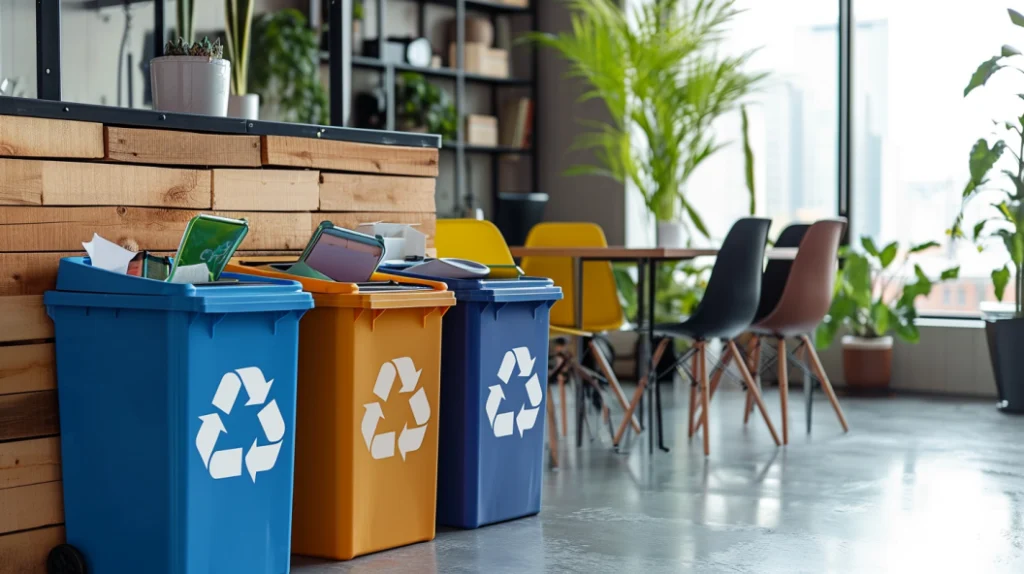
Reduce, Reuse, Recycle for an Eco-Friendly Office
Implementing the “Three R’s” (reduce, reuse, recycle) is crucial for achieving an eco-friendly workspace. By adopting sustainable waste management practices, businesses can significantly reduce their environmental impact and promote a greener office environment.
Start by limiting the use of disposable items in your office. Encourage employees to bring their reusable items from home, such as water bottles, coffee mugs, and lunch containers. This simple switch can greatly reduce the amount of waste generated in your workplace.
Reusing items wherever possible is another effective strategy. Instead of throwing away envelopes, folders, or boxes, encourage employees to repurpose them for future use. Not only does this save money, but it also reduces the demand for new materials and decreases waste.
Implementing a comprehensive recycling program is essential. Provide clearly labeled recycling bins for paper, plastic, metal, and electronic waste throughout the office. Educate employees about what can and cannot be recycled to ensure proper disposal.
To make it easier for employees to participate in recycling, position the recycling bins in conveniently accessible areas. Consider placing recycling bins next to regular trash cans and near high-traffic areas to encourage proper waste disposal.
Remember to include electronic waste in your recycling program. Many electronic devices contain hazardous materials that can contaminate the environment if not disposed of correctly. Partner with local recycling facilities or organizations that specialize in electronic waste recycling to ensure these items are properly handled.
Benefits of Implementing a Recycling Program
Implementing a recycling program in your office has several benefits:
- Reduces the amount of waste sent to landfills
- Conserves natural resources
- Saves energy used in the production of new materials
- Decreases pollution and greenhouse gas emissions
- Demonstrates your commitment to sustainability to your employees and customers
Example Recycling Program
| Recyclable Material | Designated Bin |
|---|---|
| Paper | Paper Recycling Bin |
| Plastic | Plastic Recycling Bin |
| Metal | Metal Recycling Bin |
| Electronic Waste | Designated Electronic Waste Recycling Bin |
Make sure to periodically review and evaluate the success of your recycling program. Assess whether any adjustments or improvements are necessary to ensure its effectiveness. By reducing waste, reusing items, and implementing a comprehensive recycling program, your office can make a significant difference in creating a more sustainable future.

Promoting a Green Commute Program
Reducing carbon emissions and promoting sustainable transportation options are crucial steps towards creating an eco-conscious work environment. By encouraging employees to embrace sustainable commuting alternatives, businesses can make a significant impact on the environment and foster a greener workplace.
Implementing a green commute program allows employees to choose environmentally friendly transportation options for their daily commute. This program can include initiatives such as:
- Carpooling: Encouraging employees to share rides by carpooling with colleagues who live in the same area. By reducing the number of personal vehicles on the road, carpooling helps decrease traffic congestion and carbon emissions.
- Biking and walking: Promoting the use of bikes or walking as a means of transportation for short distances. These sustainable alternatives not only contribute to a healthier lifestyle but also minimize pollution and traffic congestion.
- Public transportation: Encouraging employees to utilize public transportation options such as buses, trains, or subways. Public transportation reduces the number of vehicles on the road and provides a more sustainable mode of transportation for daily commuting.
- Remote work: Offering remote work opportunities can significantly reduce the need for commuting and associated carbon emissions. Remote work allows employees to work from home or other remote locations, eliminating the need for daily commutes.
By providing incentives for employees who choose greener transportation options, businesses can promote and encourage sustainable commuting practices. These incentives can include preferred parking for carpoolers, reimbursement for public transportation expenses, or even offering flexible work schedules that align with public transportation timetables.
Carpooling, biking, walking, public transportation, and remote work all contribute to a sustainable and eco-friendly work environment. By actively promoting these options, businesses can play a vital role in reducing their carbon footprint and creating a greener future.
By promoting a green commute program, businesses demonstrate their commitment to sustainability and inspire employees to embrace sustainable transportation options. This not only benefits the environment but also enhances employee well-being and fosters a sense of collective responsibility towards environmental conservation.
| Transportation Method | Benefits |
|---|---|
| Carpooling | – Reduction in traffic congestion – Decreased carbon emissions |
| Biking and walking | – Healthier lifestyle – Reduced pollution and traffic congestion |
| Public transportation | – Minimized pollution – Decreased dependency on personal vehicles |
| Remote work | – Elimination of daily commuting – Reduced carbon emissions |
Promoting a green commute program is not only an environmentally responsible choice but also a strategic investment in creating a sustainable work environment. By encouraging employees to choose sustainable transportation options, businesses can take active steps towards reducing their carbon footprint and contributing to a greener future.

Incorporating Indoor Greenery for a Healthy Workspace
Transform your office into a vibrant and health-conscious space by incorporating indoor greenery. Not only do office plants enhance the aesthetic appeal of your workspace, but they also offer a myriad of benefits for both the environment and your well-being. Let’s explore how indoor greenery can improve air quality, reduce stress, and boost employee productivity and satisfaction.
Indoor plants play a vital role in improving air quality by absorbing toxins and releasing oxygen. By introducing office plants, you can create a healthier work environment, reducing the presence of harmful pollutants and fostering cleaner air for you and your colleagues to breathe. This improvement in air quality can help alleviate respiratory issues and enhance overall well-being.
Moreover, the presence of indoor greenery has been shown to have a positive impact on stress reduction. Studies indicate that being surrounded by nature and natural elements, even indoors, can significantly lower stress levels. The calming effect of plants can create a more peaceful and tranquil atmosphere in your workspace, promoting a healthier work-life balance and improving overall job satisfaction.
Additionally, office plants have been proven to enhance employee productivity. The presence of greenery in the office has been linked to increased focus, creativity, and concentration. Indoor plants not only provide a visually appealing backdrop but also create a sense of calm and tranquility that can positively impact workflow and task performance.
To reap the maximum benefits of indoor greenery, consider incorporating a variety of office plants that thrive in your workspace’s lighting and temperature conditions. Examples of low-maintenance office plants that are great for improving air quality include the Snake Plant, Spider Plant, and Peace Lily. These plants are easy to care for and can effortlessly bring the benefits of indoor greenery to your office.
A visually appealing and productive workspace awaits you with the incorporation of indoor greenery. Take advantage of the numerous benefits of office plants, including improved air quality, reduced stress levels, and increased employee productivity. By nurturing a greener and healthier work environment, you can contribute to a sustainable and eco-conscious future.
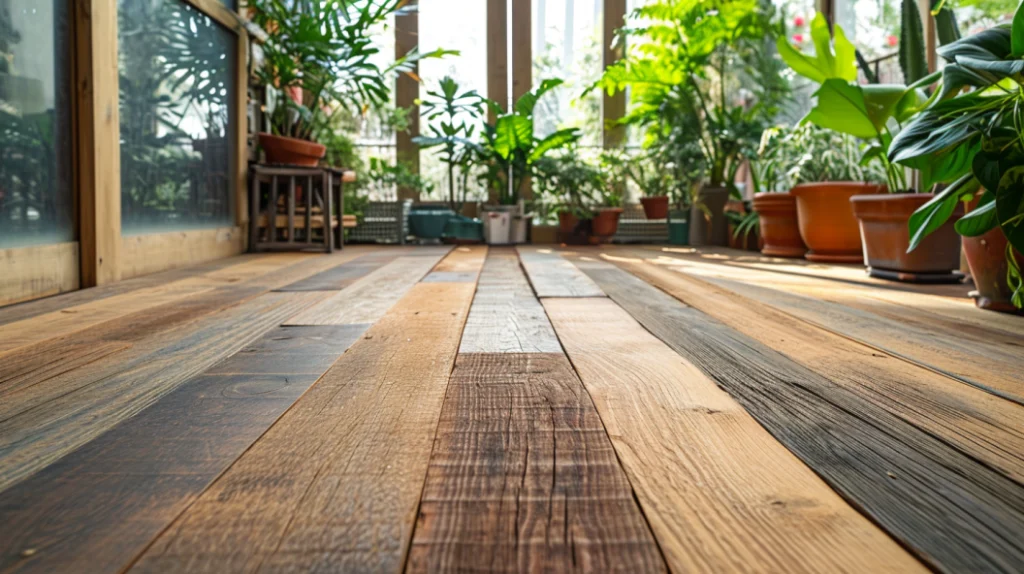
Green Building Materials and Design for Office Renovations
When it comes to office renovations or new constructions, incorporating green building materials and sustainable design not only benefits the environment but also contributes to a healthier and more energy-efficient workspace. By choosing environmentally friendly alternatives like reclaimed wood, bamboo, and recycled steel, companies can reduce their carbon footprint and promote a greener future.
Reclaimed wood is an excellent choice for office renovations as it not only adds a touch of rustic charm but also minimizes the demand for new timber. By repurposing wood from old buildings, barns, or wine barrels, businesses can give these materials a new life and reduce the need for deforestation. In addition, reclaimed wood offers unique textures and character that cannot be replicated with new materials.
Another sustainable option to consider is bamboo. Due to its rapid growth rate, bamboo is highly renewable and can be harvested without causing significant environmental impact. This lightweight and durable material is ideal for various office applications, such as flooring, furniture, and wall panels. By choosing bamboo products, companies can support sustainable sourcing practices and contribute to the preservation of forests.
Recycled steel is another green building material that offers numerous benefits for office renovations. This material not only saves energy and reduces greenhouse gas emissions during the manufacturing process but also has exceptional durability and strength. Recycled steel is commonly used in structural components, interior partitions, and furniture, making it a versatile and sustainable choice for office design.
To enhance the sustainability of office spaces further, incorporating green roofs and walls can have a significant impact. Green roofs consist of living plants and vegetation that cover the top of a building, providing insulation and reducing energy consumption. These green features help regulate temperature, retain rainwater, enhance air quality, and create a visually appealing environment for employees. Similarly, green walls or vertical gardens can be installed inside the office, offering similar benefits and improving the overall aesthetic.
Benefits of Green Building Materials and Design
Opting for green building materials and sustainable design in office renovations brings several benefits. Firstly, it reduces the environmental impact by minimizing the use of virgin resources, limiting waste, and lowering carbon emissions. Secondly, these materials often have superior durability, requiring less maintenance and replacement over time. This not only reduces costs but also contributes to a more sustainable and long-lasting office space.
Moreover, incorporating green roofs and walls enhances the insulation properties of the office, leading to energy savings by reducing the need for heating and cooling. Additionally, these features improve air quality, creating a healthier and more comfortable work environment for employees. The presence of natural elements and greenery has also been linked to higher levels of productivity, stress reduction, and overall well-being.
| Benefits of Green Building Materials and Design |
|---|
| Reduces environmental impact by minimizing the use of virgin resources |
| Superior durability |
| Lower maintenance and replacement costs |
| Improved insulation and energy savings |
| Enhanced air quality and employee health |
| Increased productivity and reduced stress |
Incorporating green building materials and sustainable design elements not only aligns with the company’s commitment to environmental responsibility but also showcases their dedication to creating a healthy and inspiring workspace for employees. By choosing these materials, businesses can pioneer sustainable practices and set an example for others in the industry.

Encouraging Green Education in the Workplace
Cultivating a green culture in the workplace is essential for maintaining an eco-friendly office environment. By offering sustainability training sessions, workshops, or creating an “Eco Team,” you can educate employees about the importance of sustainability. When employees understand the significance of their actions, they are more likely to make environmentally friendly choices in the office.
Creating a sustainable and eco-conscious office culture involves providing resources and opportunities for green education. By offering sustainability training programs, you can empower employees to incorporate sustainable practices into their everyday work routines. These training sessions can cover topics such as energy conservation, waste management, recycling, and the use of eco-friendly office supplies.
Workshops can be organized to provide a more hands-on approach to learning about sustainability. These workshops can focus on specific aspects of green education, such as reducing paper usage, implementing energy-saving practices, or promoting a green commute program.
One effective way to drive employee engagement and environmental awareness is by establishing an “Eco Team” within the organization. The Eco Team can be responsible for organizing sustainability initiatives, educating employees about eco-friendly practices, and spearheading green projects. This team can help create a sense of ownership and collaboration among employees in adopting sustainable practices.
The benefits of green education in the workplace are multi-fold. First, it raises awareness about environmental issues and fosters a sense of responsibility among employees. Second, it empowers employees to make conscious choices in their daily work activities that align with sustainability goals. Third, it creates a supportive and inspiring work environment where everyone is committed to making a positive impact on the environment.
By investing in green education and promoting an eco-conscious office culture, businesses can create a more sustainable workplace and contribute to a greener future.
Benefits of Green Education in the Workplace:
- Raises awareness about environmental issues
- Fosters a sense of responsibility among employees
- Empower employees to make conscious choices aligned with sustainability goals
- Creates a supportive and inspiring work environment
- Contributes to a greener future
Quick Facts about Green Education in the Workplace
| Fact | Description |
|---|---|
| Eco-conscious Office Culture | Creating a workplace culture that prioritizes sustainability and environmental awareness. |
| Employee Engagement | Involving employees in sustainability initiatives and encouraging them to actively participate. |
| Environmental Awareness | Raising awareness about the impact of individual actions on the environment. |
| Green Education | Providing training sessions and workshops on sustainability and eco-friendly practices. |
| Sustainability Training | Teaching employees about sustainable practices and their role in creating a greener workplace. |
Final Thoughts on Green Home Office
Transitioning to a green and sustainable office is an ongoing journey that requires time and commitment. By incorporating sustainable work practices and embracing eco-conscious business strategies, you can create a work environment that not only benefits the planet but also enhances employee well-being. Making conscious choices towards sustainability today can have a significant and positive long-term impact on the future of our planet.
By implementing green office practices such as harnessing natural light, using energy-efficient appliances, choosing sustainable printing solutions, opting for green office supplies, practicing the three R’s (reduce, reuse, recycle), promoting a green commute program, incorporating indoor greenery, and using green building materials and design, you can create a sustainable work environment that aligns with your values and supports a greener future.
Embracing an eco-conscious business model goes beyond surface-level changes; it involves integrating sustainability into the core values of your organization. By fostering a culture of green education, providing sustainability training, and promoting environmental awareness among your employees, you can create a sustainable work environment that inspires positive change within and beyond your office walls. Remember, every small step towards sustainability matters and contributes to building a better future for generations to come.
FAQ
What are some strategies for creating a green home office?
Strategies for creating a green home office include harnessing natural light, using energy-efficient appliances, implementing sustainable commercial printing solutions, opting for green office supplies, practicing the three R’s (reduce, reuse, recycle), promoting a green commute program, incorporating indoor greenery, using green building materials and design, encouraging green education, and embracing the transition to remote work.
How can natural light be utilized in a home office?
Natural light can be utilized in a home office by incorporating skylights, large windows, and light shelves to maximize sunlight penetration. This not only reduces reliance on artificial lighting but also provides health benefits such as improved mood, reduced eye strain, and enhanced productivity.
How can energy efficiency be achieved in a home office?
Energy efficiency can be achieved in a home office by using energy-efficient appliances with an Energy Star rating. Opting for energy-efficient computers, printers, coffee makers, and HVAC systems can significantly reduce carbon emissions and contribute to a more sustainable workspace.
What are some sustainable practices for commercial printing?
Sustainable practices for commercial printing include using printers with an Energy Star rating, choosing recycled or Forest Stewardship Council certified paper, reducing font size, printing double-sided, and using refillable cartridges. These practices help to reduce environmental impact and waste.
How can I choose green office supplies?
To choose green office supplies, opt for pens made from recycled plastic, paper products made from recycled or FSC certified paper, and biodegradable cleaning products. While these alternatives may have a slightly higher initial cost, they have a positive environmental impact in the long run.
What can businesses do to promote an eco-friendly office environment?
Businesses can promote an eco-friendly office environment by implementing the “Three R’s” (reduce, reuse, recycle), limiting the use of disposable items, encouraging employees to bring reusable items from home, and implementing a comprehensive recycling program. These practices help to reduce waste and create a sustainable office environment.
How can businesses encourage sustainable commuting?
Businesses can encourage sustainable commuting by promoting options such as carpooling, biking, walking, or using public transportation. Providing incentives for employees who choose these greener options or offering remote work opportunities can also contribute to a more eco-conscious work environment.
What are the benefits of incorporating indoor greenery in the workspace?
Incorporating indoor plants in the workspace enhances aesthetics, improves air quality, reduces stress, and boosts employee productivity and satisfaction. Indoor plants absorb toxins and release oxygen, contributing to a healthier and greener work environment.
How can green building materials and design be incorporated in office renovations?
Green building materials and design can be incorporated in office renovations by using environmentally friendly alternatives such as reclaimed wood, bamboo, and recycled steel. Additionally, incorporating green roofs and walls can improve insulation and reduce the heating and cooling energy needs of the office space.
How can businesses promote green education in the workplace?
Businesses can promote green education in the workplace by offering sustainability training sessions, workshops, or creating an “Eco Team” to spearhead sustainability efforts. This helps to educate employees about the importance of sustainability and encourages them to make environmentally friendly choices in the office.
What is the long-term impact of creating a sustainable work environment?
Creating a sustainable work environment has a significant and positive long-term impact on the planet and employee well-being. By incorporating green practices and promoting an eco-conscious culture, businesses can contribute to environmental conservation and a healthier future.


